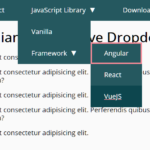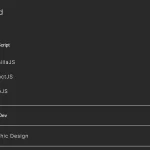| Author: | jhonatan-oliveiradev |
|---|---|
| Views Total: | 2,970 views |
| Official Page: | Go to website |
| Last Update: | April 18, 2022 |
| License: | MIT |
Preview:

Description:
As more and more people start using their mobiles to browse the web, it is more important than ever to make sure that your website is mobile friendly.
This is a modern, mobile-friendly navigation system that enables a hamburger button to expand and collapse a dropdown menu with smooth slide animations. Have fun with it.
Written entirely in plain JavaScript, HTML, and CSS. No third-party frameworks or libraries are needed.
How to use it:
1. Code the HTML for the dropdown menu.
<div class="navigation">
<div class="userBx">
<div class="imgBx">
<img src="user.jpg" alt="user avatar" />
</div>
<p class="username">CSSScript</p>
</div>
<div class="menuToggle"></div>
<ul class="menu">
<li>
<a href="#">Profile</a>
</li>
<li>
<a href="#">Message</a
>
</li>
<li>
<a href="#">Notification</a
>
</li>
<li>
<a href="#">Settings</a>
</li>
<li>
<a href="#">Help</a
>
</li>
<li>
<a href="#">Logout</a>
</li>
</ul>
</div>2. The necessary CSS styles for the dropdown menu.
.navigation {
position: fixed;
top: 20px;
right: 20px;
width: 120px;
height: 60px;
background: #fff;
box-shadow: 0 25px 35px rgba(0, 0, 0, 0.1);
display: flex;
justify-content: space-between;
transition: height 0.5s, width 0.5s;
transition-delay: 0s, 0.75s;
overflow: hidden;
}
.navigation.active {
width: 300px;
height: 400px;
transition: width 0.5s, height 0.5s;
transition-delay: 0s, 0.75s;
}
.navigation .userBx {
position: relative;
width: 60px;
height: 60px;
background: #fff;
display: flex;
align-items: center;
overflow: hidden;
transition: 0.5s;
transition-delay: 0.5s;
}
.navigation.active .userBx {
width: calc(100% - 60px);
transition-delay: 0s;
}
.navigation .userBx .username {
white-space: nowrap;
color: #555;
font-size: 1.1em;
}
.navigation .userBx .imgBx {
position: relative;
min-width: 60px;
height: 60px;
overflow: hidden;
background: #000;
border-radius: 50%;
border: 10px solid #fff;
}
.navigation .userBx .imgBx img {
position: absolute;
top: 0;
left: 0;
width: 100%;
height: 100%;
object-fit: cover;
}
.menu {
position: absolute;
width: 100%;
height: calc(100% - 60px);
margin-top: 60px;
padding: 20px;
border-top: 1px solid rgba(0, 0, 0, 0.1);
}
.menu li {
list-style: none;
}
.menu li a {
display: flex;
align-items: center;
gap: 10px;
margin: 20px 0;
font-size: 1em;
text-decoration: none;
color: #555;
}
.menu li a:hover {
color: #4e65ff;
}
.menu li a ion-icon {
font-size: 1.5em;
}3. Apply CSS styles to the hamburger toggle button.
.navigation .menuToggle {
position: relative;
width: 60px;
height: 60px;
background: #fff;
cursor: pointer;
display: flex;
justify-content: center;
align-items: center;
}
.navigation .menuToggle::before {
content: "";
position: absolute;
width: 32px;
height: 2px;
background: #555;
transform: translateY(-10px);
box-shadow: 0 10px #555;
transition: 0.5s;
}
.navigation .menuToggle::after {
content: "";
position: absolute;
width: 32px;
height: 2px;
background: #555;
transform: translateY(10px);
transition: 0.5s;
}
.navigation.active .menuToggle::before {
transform: translateY(0px) rotate(45deg);
box-shadow: 0 0 #555;
}
.navigation.active .menuToggle::after {
transform: translateY(0px) rotate(-45deg);
}4. The required JavaScript to toggle CSS classes based on the menu state.
let menuToggle = document.querySelector(".menuToggle");
let navigation = document.querySelector(".navigation");
menuToggle.onclick = function () {
navigation.classList.toggle("active");
};









